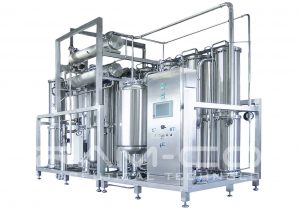COMPENDIAL WATERS IN INTERNATIONAL PHARMACOPOEIAS
Water is employed as ingredient in many processes, formulations and products. The International pharmacopoeieas (USP, Ph. Eur., JP) define as “Water For Injection” only the compendial water used as an excipient to parenteral solutions. ISPE Glossary distinguishes
– WFI in bulk: “Water for the preparation of medicines for parenteral administration when water is used as a vehicle”;
– Sterilized WFI: ” (Water) for dissolving or diluting substances or preparations for parenteral administration before use”.
The finished water meets all the chemical requirements for PW (Purified Water). With an additional bacterial endotoxin parameter, is the specific WFI character. Since endotoxins are produced by microorganisms that are prone to spread in the water, the equipment and the procedures used by the production lines to purify, store and distribute WFI must prevent the build-up of endotoxin and minimize microbial contamination in the system.
DISTILLATION IS THE MAIN WAY TO PRODUCE WATER FOR INJECTION (WFI)
The main metod of WFI production is distillation; most pharmaceutical WFI is produced by this system. Ph. Eur. pharmacopoeia admits only distillation as a method for producing compendial Water For Injection. USP pharmacopoeia admits also a “purification process proven to be equal to or superior to distillation”, while JP pharmacopoeia admits, in addition to distillation, the reverse osmosis (RO) plus ultra filtration (UF). However, all three pharmacopoeias pose the same limit for the endotoxine level (0.25 euml), for TOC values, (ppb ≤ 500), for the bacterial load (<10, Colony-Forming Units / 100 mL) and for the value of conductivity (1.3 µS/cm@25°C).
WATER FOR INJECTION IN BULK* |
||
| PHISICAL / CHEMICAL | Ph. Eur. | USP |
| Appearance | Colorless, clear | Not defined |
| Conductivity | ≤ 1.1 μS/cm@20°C | ≤ 1.3 μS/cm @25°C |
| TOC | ≤ 0.5 mg/L | ≤ 0.50 mg/L |
| Nitrates NO₃ | ≤ 0.2 ppm | Not defined |
| Aluminium | ≤ 10 ppb | Not defined |
| MICROBIOLOGICAL | Ph. Eur. | USP |
| Bacterial count | ≤ 10 CFU/100 ml | ≤ 10 CFU/100 ml |
| Bacterial endotoxins | < 0.25 IU/ml | < 0.25 EU/ml |
*data can change without notice
STERILE MEDICINAL PRODUCTS |
Minimum acceptable quality of water* |
|---|---|
| Biologics (including vaccines and ATMP) | (WFI) Water for Injection |
| Parenteral | (WFI) Water for Injection |
| Ophthalmic (excluding ATMP) | (PW) Purified Water |
| Haemofiltration Solutions / Haemodiafiltration Solutions | (WFI) Water for Injection |
| Peritoneal Dialysis Solutions | (WFI) Water for Injection |
| Irrigation Solutions | (WFI) Water for Injection |
| Nasal/Ear Preparations | (PW) Purified Water |
| Cutaneous Preparations | (PW) Purified Water |
Source: EMA/CHMP/CVMP/QWP/496873/2018. Release: 13 November 2018. Note that the finished water meets all the chemical requirements for PW (Purified Water). And, with an additional bacterial endotoxin parameter, the water meets the specific WFI character. Since microorganisms that are prone to spread in the water produce endotoxins, the equipment and the procedures used by the production lines to purify, store and distribute WFI must prevent the build-up of endotoxin and minimize microbial contamination in the system.
There are two basic technologies, that have marked the history of the pharmaceutical industry: the Vapor Compression (VC) distillation system, by vapor compression stills, and the Multiple Effect (ME) distillation system, by multi stage stills.
The FIRST advantage of Vapor Compression is a higher energy efficiency (low cost by quantity produced) (see our related site: vapor-compression-distiller.com).
The FIRST advantage of Multiple Effect distillation is less moving parts (with lower maintenance requirement).
MULTIPLE EFFECT VS VAPOR COMPRESSION TECHNOLOGY
| PARAMETERS | MULTIPLE EFFECT DISTILLER | VAPOR COMPRESSION DISTILLER |
| OUPUT FLEXIBILITY | Reduced output modulation | Capacity ranging from 0 to max. cap. of the still |
| TEMPERATURE FLEXIBILITY | WFI output 85÷99°C | WFI output from infeed water T + 10°C till 99°C |
| HEATING MEDIA FLEXIBILITY | Industrial steam or electricity | Industrial Steam and/or electricity |
| COOLING WATER | High consumption depending on quantity of columns | No cooling water required |
| FEED WATER | SI02 < 1 ppm, amines free resins (in case of DI), double stage RO preferred | SI02 <30 ppm, Single stage RO or even softened water acceptable |
| FEED WATER INPUT | Must be higher than primary steam pressure | < 1 bar |
| WFI OUTPUT | Atmospheric pressure | 1 / 1.5 bars |
| WFI QUALITY | 0.2÷0.5 microS/cm with FW <1.2microS | 0.15÷0.4 microS/cm with FW <100microS |
| PREVALIDATION (endotoxin challenge) | Yes | Yes |
| HEAVY METALS | Free | Free + elimination of chlorine solvents |
| MOVING PARTS | Feed pump | Compressor, Recirculation pump |
| PURE STEAM FROM 1ST COL. | Possible | Possible |
| STRESS CORROSION | Very high. “Rouging” percentage higher | Very low |
| CLEANABILITY | More tough than VCD | More easy than MED |
| START UP | SCADA (15 min for steam heating | SCADA (15÷40 min, for steam heating) |
Multiple Effect – Vapor Compression distillation – COMPARISON TABLE Data can change without notice
